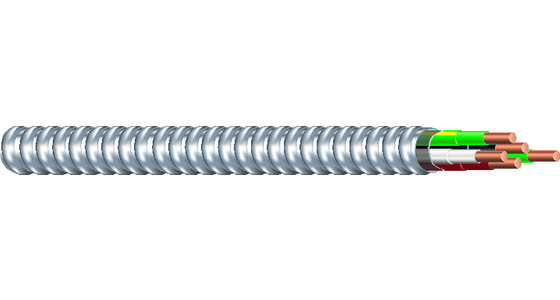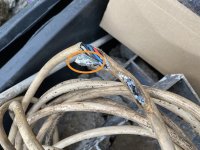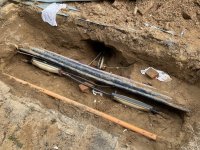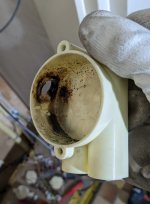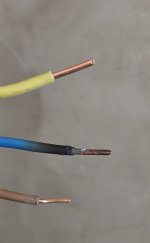six-point socket II
Member
- Joined
- Jun 26, 2016
- Messages
- 2,232
Hi everyone!
A little over 6 years ago I had to repair and partly replace an electrical line coming from our basement feeding the garden & sheds.
Initially I wanted to replace the whole line, but that wasn't an option 6 years ago because I couldn't get the access needed for that. At least not within a feasible amount of time and without a lot of additional work afterwards.
So I opted to replace only a part of the line and repair the joint. I chose BBC Cellpack's "Easycell(R)" gel-technology straight-joint boxes for that repair. They come as box pre-packed with gel and a connector terminal. ->https://electricalproducts.cellpack.com/en/gel-technology/easycell/
They also now have an incredible gel-technology product line suiting the Wago 221 line of connectors that we all love. ->https://electricalproducts.cellpack.com/en/gel-technology/easy-protect/
This year was packed with many major refurbishment projects & one of them finally got me the access needed to replace the whole line. So it was a no-brainer to do it. That then lead to the interesting chance of taking out the Easycell(R) boxes and have a closer look at them after being buried and used for roughly 6 years.
When I buried them I did cover them just in case and for visibility if I had to dig again in that area - that cover removed they look pretty clean & sound.
[attachimg=1]
Cut out & on the table.
[attachimg=2]
Sideview. The gel neatly enclosed the cable. (1 picture, looked exactly the same on the remaining 3 sides)
[attachimg=3]
Let's open them.
Box 1
[attachimg=4]
[attachimg=5]
Box 2
[attachimg=6]
[attachimg=7]
As you can see, the cables & connectors are in absolute pristine condition. I was honestly impressed how well that worked - not to mention that over the 6 years we didn't have a single failure/issue with the garden & shed electrics.
Bonus:
I said before that I wanted to replace the whole line, and I did. And I did find what I expected speaking of the - until then not replaced - part. So here's the part (of the original line/cable) that I couldn't replace the first time I was working on this. It came out the conduit exactly like this. Since that was way oversized, my guess is some varmint (or whatever) had a go at it. Or the pre-owner damaged it while pulling it originally. It did hold up to an insulation resistance test at 250V back then, my guess is that 500V would have come back negative/ failed. When I thought of this, I sadly had already disposed of all the trash, so I couldn't do the experiment.
[attachimg=8]
[attachimg=9]
[attachimg=10]
Kind regards,
Oliver
A little over 6 years ago I had to repair and partly replace an electrical line coming from our basement feeding the garden & sheds.
Initially I wanted to replace the whole line, but that wasn't an option 6 years ago because I couldn't get the access needed for that. At least not within a feasible amount of time and without a lot of additional work afterwards.
So I opted to replace only a part of the line and repair the joint. I chose BBC Cellpack's "Easycell(R)" gel-technology straight-joint boxes for that repair. They come as box pre-packed with gel and a connector terminal. ->https://electricalproducts.cellpack.com/en/gel-technology/easycell/
They also now have an incredible gel-technology product line suiting the Wago 221 line of connectors that we all love. ->https://electricalproducts.cellpack.com/en/gel-technology/easy-protect/
This year was packed with many major refurbishment projects & one of them finally got me the access needed to replace the whole line. So it was a no-brainer to do it. That then lead to the interesting chance of taking out the Easycell(R) boxes and have a closer look at them after being buried and used for roughly 6 years.
When I buried them I did cover them just in case and for visibility if I had to dig again in that area - that cover removed they look pretty clean & sound.
[attachimg=1]
Cut out & on the table.
[attachimg=2]
Sideview. The gel neatly enclosed the cable. (1 picture, looked exactly the same on the remaining 3 sides)
[attachimg=3]
Let's open them.
Box 1
[attachimg=4]
[attachimg=5]
Box 2
[attachimg=6]
[attachimg=7]
As you can see, the cables & connectors are in absolute pristine condition. I was honestly impressed how well that worked - not to mention that over the 6 years we didn't have a single failure/issue with the garden & shed electrics.
Bonus:
I said before that I wanted to replace the whole line, and I did. And I did find what I expected speaking of the - until then not replaced - part. So here's the part (of the original line/cable) that I couldn't replace the first time I was working on this. It came out the conduit exactly like this. Since that was way oversized, my guess is some varmint (or whatever) had a go at it. Or the pre-owner damaged it while pulling it originally. It did hold up to an insulation resistance test at 250V back then, my guess is that 500V would have come back negative/ failed. When I thought of this, I sadly had already disposed of all the trash, so I couldn't do the experiment.
[attachimg=8]
[attachimg=9]
[attachimg=10]
Kind regards,
Oliver
Attachments
-
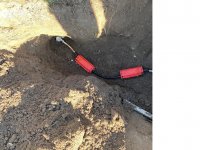 IMG_6808.jpg190 KB · Views: 362
IMG_6808.jpg190 KB · Views: 362 -
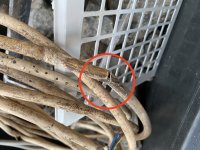 IMG_6850.jpg242.6 KB · Views: 338
IMG_6850.jpg242.6 KB · Views: 338 -
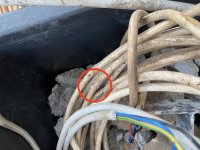 IMG_6849.jpg120.3 KB · Views: 323
IMG_6849.jpg120.3 KB · Views: 323 -
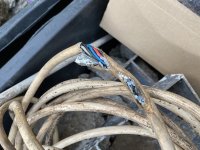 IMG_6848.jpg231.7 KB · Views: 328
IMG_6848.jpg231.7 KB · Views: 328 -
 IMG_6871.jpg291.1 KB · Views: 326
IMG_6871.jpg291.1 KB · Views: 326 -
 IMG_6868.jpg336.6 KB · Views: 329
IMG_6868.jpg336.6 KB · Views: 329 -
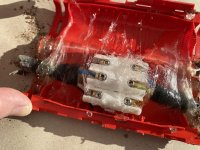 IMG_6862.jpg274 KB · Views: 331
IMG_6862.jpg274 KB · Views: 331 -
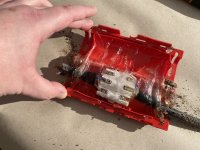 IMG_6860.jpg299.9 KB · Views: 315
IMG_6860.jpg299.9 KB · Views: 315 -
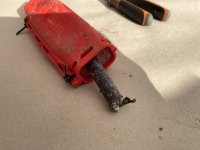 IMG_6857.jpg217 KB · Views: 356
IMG_6857.jpg217 KB · Views: 356 -
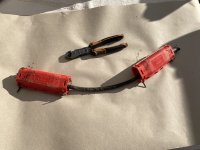 IMG_6852.jpg287.4 KB · Views: 365
IMG_6852.jpg287.4 KB · Views: 365

